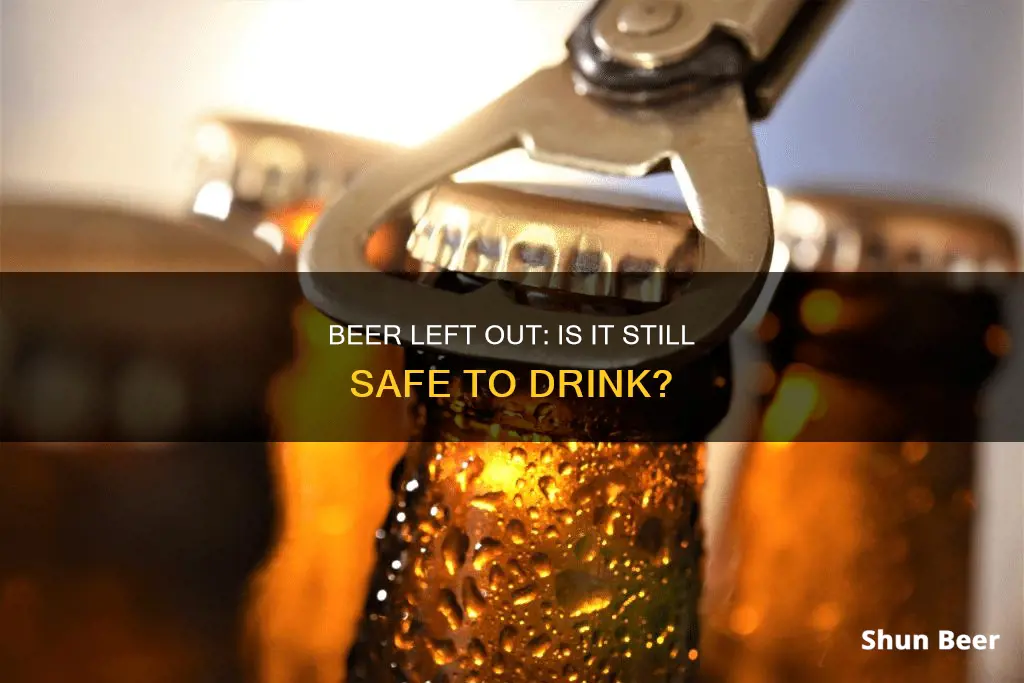
Whether you can drink a beer that has been left out depends on several factors, including the type of beer, the temperature it was left in, and the length of time it was left out. Generally, an unopened beer can stay at its optimal quality for about 4 to 6 months when stored at room temperature. However, if the beer is opened, it is best to drink it within 1-2 days to enjoy its best flavor. While you can still drink it after it has been left out overnight, it may be flat and have lost its initial flavor.
| Characteristics | Values |
|---|---|
| Beer left out of the fridge | Safe to drink |
| Beer left out in the sun | Safe to drink but may taste bad |
| Beer left out in extreme heat | May ruin the beer |
| Beer left open | Fresh for 1-2 days |
| Beer left open for three days | Safe to drink but may not taste pleasant |
| Beer left open for 24-48 hours | Likely to lose its carbonation, flavour and freshness |
| Beer left open for longer than 24-48 hours | Likely to be flat without its initial flavour |
| Beer left open and then refrigerated | Overall quality and taste may be affected |
| Beer left open and exposed to UV rays | Likely to go off |
| Beer left open and exposed to oxygen | Likely to go off |
| Beer left open and exposed to bacteria | Likely to go off |
What You'll Learn

Beer left out in the sun can be ruined
Beer is sensitive to temperature changes and extreme heat, especially when exposed to direct sunlight. While it may still be safe to drink a beer that has been left out in the sun, the quality and taste will likely be affected, and it may ruin the beer.
The sun's UV rays are known to shorten a beer's shelf life. They can penetrate the bottle and trigger a chemical reaction that breaks down its taste components, causing flavour deterioration. This process is more prominent in beers like India Pale Ales and other light beers, which are best consumed within three months of packaging.
Additionally, rapid temperature changes can negatively impact the brew's quality and taste. A quick change from cool to warm is worse for beer than a steady room temperature. However, extreme heat (above 80 degrees Fahrenheit) will ruin beer, and it is not recommended to leave it in a hot garage or out in the sun.
Oxygen exposure is another factor that affects beer's shelf life and quality. When oxygen comes into contact with the beer, it can cause oxidation, degrading the beverage's flavour and changing its colour. Bottled beer is more susceptible to oxygen exposure than canned beer, and it is recommended to store beer upright to reduce the surface area exposed to oxygen.
If you have left your beer out in the sun, it is important to check for signs of spoilage before consuming it. Strange smells, tastes, or cloudiness in the beer could indicate bacterial contamination or oxidation. While it may be safe to drink, the beer will likely be less enjoyable due to flavour and quality deterioration caused by the sun's UV rays and temperature changes.
Non-Alcoholic Beer: Safe Post-Liver Transplant?
You may want to see also

An open beer is fresh for 1-2 days
Beer is a beloved beverage for many, but what happens if you leave it out after it's been opened? Well, it depends on a few factors. Firstly, let's clarify that we're talking about beer that has already been refrigerated and then left out, as fresh beer delivered or purchased at room temperature is generally fine if stored at room temperature.
Now, onto the main question: an open beer is typically fresh for 1-2 days. After this timeframe, it will likely be stale and flat, and its taste will deteriorate. This is because oxygen exposure and temperature fluctuations affect an open beer's shelf life and quality. Warm temperatures above room temperature will cause the beer to spoil faster, while refrigeration helps maintain its freshness.
It's important to note that even after 1-2 days, an open beer won't pose any significant health risks if consumed, but its taste will be far from pleasant. Additionally, rapid temperature changes, such as freezing and then thawing the beer, should be avoided as they can affect carbonation levels and facilitate spoilage.
To extend the shelf life of an open beer, it's recommended to seal the bottle or can tightly and store it upright in a cool, dry, and dark place, like a pantry or cellar, with temperatures between 35 and 55 degrees Fahrenheit (2 to 13 degrees Celsius). This will help minimize oxygen exposure and slow down flavor degradation.
Chugging Beer: How Fast Can You Go?
You may want to see also

Beer can be drunk after being left out overnight
Beer is a beloved beverage for many, and it's essential to handle it with care to preserve its quality and taste. While leaving beer out overnight may not be ideal, it's good to know that it's typically safe to drink. Here's a detailed exploration of this topic.
Beer's Shelf Life and Sensitivity to Temperature
The shelf life of beer depends on several factors, including whether it's open or sealed. Sealed beer, when stored at room temperature, can maintain its optimal quality for about four to six months. However, once opened, beer is best consumed within one to two days to enjoy its freshest flavour. Leaving beer out overnight will likely affect its taste and freshness, but it's still safe to drink.
Temperature plays a pivotal role in determining beer's shelf life. Extreme heat, such as temperatures above 80 degrees Fahrenheit, will ruin beer. On the other hand, storing beer in a refrigerator prolongs its freshness. The ideal storage temperature for beer is between 35°F and 46°F.
Impact of Oxygen and UV Rays
Oxygen exposure is another critical factor affecting beer's quality. When beer comes into contact with oxygen, it can undergo oxidation, leading to flavour degradation and colour changes. Bottled beer is more susceptible to oxygen exposure than canned beer. To minimise this, store beer upright to reduce the surface area exposed to oxygen.
UV rays are also detrimental to beer. The sun's rays penetrate bottles, triggering a chemical reaction that breaks down its taste components, resulting in flavour deterioration. This is why beer is often packaged in dark bottles to protect it from UV rays.
Signs of Spoilage and Bacterial Contamination
Spoiled beer will exhibit certain signs. If you detect unpleasant odours, such as skunk or urine, it's best not to drink it as it may indicate bacterial growth. Strange tastes, such as metallic, sour, or cardboard-like flavours, are also indicators of spoilage. Cloudiness or haze in the beer, accompanied by unusual tastes or odours, can be signs of bacterial contamination. However, some craft beers may have a hazy appearance intentionally for flavour and texture.
Tips for Extending Beer's Shelf Life
To ensure your beer lasts longer, find a cool, dry storage spot with stable temperatures between 35 and 55 degrees Fahrenheit. Avoid areas with temperature fluctuations, such as near windows or heating vents. Keep the beer away from light and, if possible, store it in a refrigerator. Always seal beer bottles or cans tightly after opening and store them upright to minimise oxygen exposure.
Baclofen and Beer: Is It Safe to Mix?
You may want to see also

Beer exposed to oxygen can go bad faster
Oxygen exposure is a significant factor in determining a beer's shelf life and quality. When oxygen comes into contact with beer, it can cause oxidation, degrading the beverage's flavour and changing its colour. Beer that has been exposed to oxygen will go bad faster.
Bottled beer is more susceptible to oxygen exposure than canned beer. To reduce the surface area exposed to oxygen, it is recommended to store beer upright.
The sun's rays are also notorious for shortening beer's shelf life. They penetrate the bottles and trigger a chemical reaction that breaks down its taste components, causing flavour deterioration.
UV rays are beer's "archenemy". Exposure to UV rays is one of the fastest ways to ruin your beer, even before its expiry date. Therefore, it is recommended to store beer in a cool, dry place away from sunlight.
Temperature plays a pivotal role in determining a beer's shelf life. Storing beer in a refrigerator prolongs its freshness. Ideally, beer should be stored at typical refrigerator conditions—35°F and 46°F.
If you don't have a fridge, choose a cool, dark place that is undisturbed by regular movements, such as a pantry or cellar. Avoid areas prone to temperature fluctuations, such as near windows or heating vents.
Zero Alcohol Beer: A Safe Choice for Diabetics?
You may want to see also

Beer should be stored in a cool, dry place
Beer is best stored in a cool, dry place, out of direct sunlight. A refrigerator is ideal, as it will slow down the beverage's flavour degradation, giving you more time to enjoy it. The optimal temperature range is between 2°C and 13°C (35°F and 46°F).
If you don't have access to a refrigerator, a cool, dark place like a pantry or cellar is a good alternative. These areas typically maintain lower temperatures and are undisturbed by regular movements, which can help prolong the beer's freshness.
It's important to keep beer away from sources of UV rays, as they can penetrate the bottles and trigger a chemical reaction that breaks down its taste components, causing flavour deterioration. This is why beer is often packaged in dark bottles. Additionally, areas prone to temperature fluctuations, such as near windows or heating vents, should be avoided, as rapid temperature changes can negatively impact the brew's quality and taste.
While it's not ideal, allowing a cold beer to become warm and then cooling it down again won't cause any significant harm to the beverage. This is a common misconception, and while it may not taste as good as a consistently cold beer, it is safe to drink.
Beer and Valtrex: Safe Mix?
You may want to see also
Frequently asked questions
Yes, it is safe to drink beer that has been left out, even if it has gone flat.
Beer can be left out for 1-2 days before it goes bad, but it is best to drink within that period to enjoy its optimal flavour.
If beer is left out for too long, it will lose its carbonation, flavour and freshness. It may also be subject to bacterial contamination, which can cause health issues.
Yes, sunlight can cause lightstrike, which can ruin the beer. Beer should be stored in a cool, dark place, away from direct sunlight.
Yes, rapid temperature changes can negatively impact the quality and taste of beer. Beer should be stored at a steady temperature.







